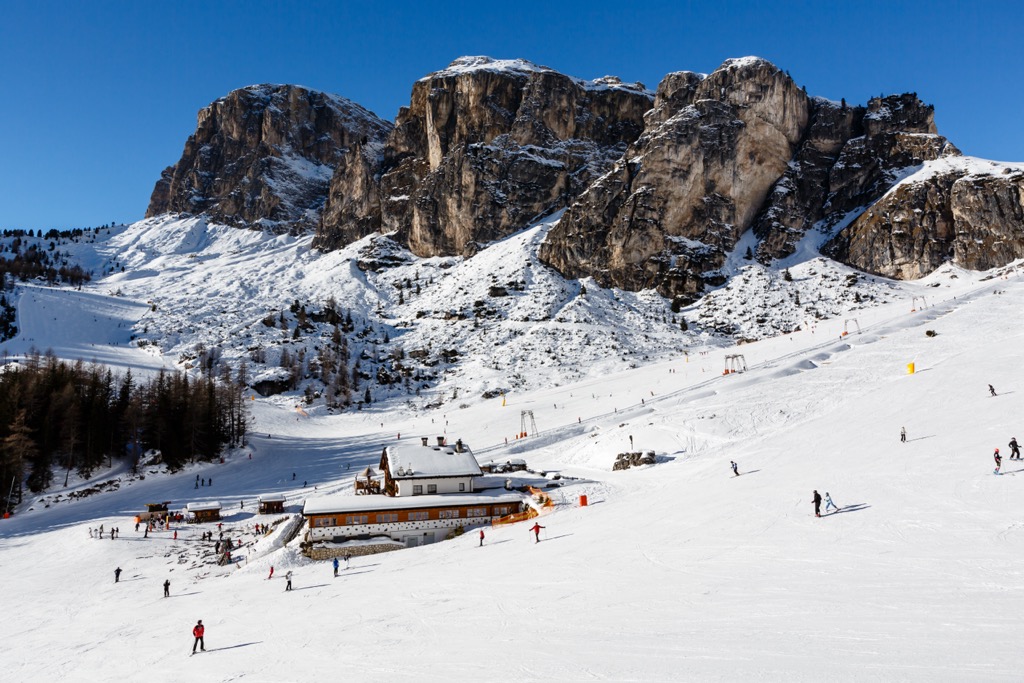Get PeakVisor App
Sign In
Search by GPS coordinates
- Latitude
- ° ' ''
- Longitude
- ° ' ''
- Units of Length
- Temperature

Yes
Cancel
Share ×

Scan the QR code and open PeakVisor on your phone
❤ Wishlist ×
Choose
Delete
On the northern edge of the Dolomites in Val Pusteria, there’s Kronplatz - one of the finest Italian ski resorts. Kronplatz (also known as Plan de Corones) sits in mostly German-speaking South Tyrol between the towns of Brunico and San Vigilio di Marebbe. The resort occupies a significant part of the mighty Kronplatz Mountain, reaching 2275 m (7,464 ft), as well as several slopes of other nearby mountains. The main feature of the ski resort is the abundance of recreational activities immersed in splendid scenery. The spectacular mountain scenery is everywhere in Kronplatz, and due to the enormous size of the ski resort, it will take many days to see everything. Just imagine 32 new mountain lifts, many with heated seats, and about 120 km (74 mi) of ski runs. It might be a challenge to ski them all in one day!
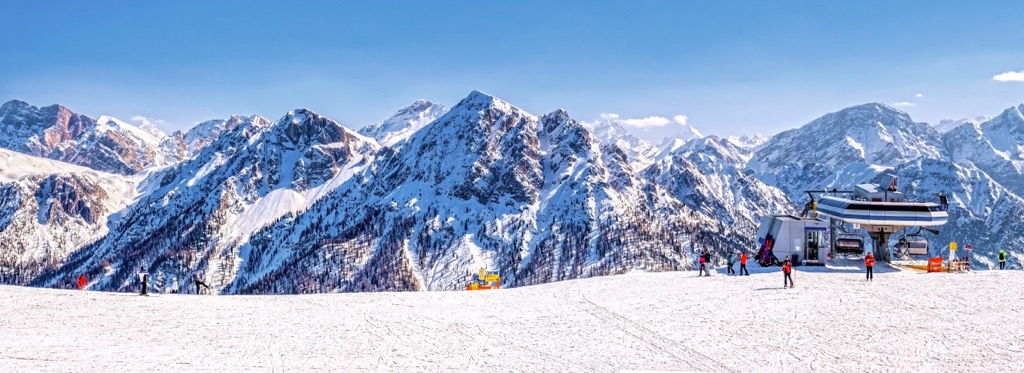
Kronplatz is a vast and prominent peak offering unobstructed 360-degree views of the Dolomites to the south (Peitlerkofel, Marmolada, Tofane) and the snow-capped Zillertal Alps (Hochfeiler, Swarzenstein, Grosser Loeffler) to the north.
Kronplatz is just north of Fanes-Sennes-Braies Natural Park and on the northern edge of the Dolomiti Superski region. The resort sits about 20 km south of the Austrian border. The closest metropolitan area is Bolzano, 96 km (59 mi) away, and the nearest large city is Munich, Germany, at 270 km (168 mi) away. Due to its location at the crossroads of Europe, people speak German, Italian, and English.
The ski area is nearby three nature parks: the iconic Tre Cime, Fanes-Sennes-Braies, and little-known yet spectacular Vedrette di Ries-Aurina Nature Park.

Bolzano is the nearest regional airport connecting to the most popular international airports, such as Innsbruck, Venice, and Treviso. The only disadvantage is the absence of international airports in close vicinity; Munich is four hours by car, and Milano Malpensa is five.
Besides cars, most visitors arrive by train at Brunico, linked to Brixen, Bolzano, and Lienz (Austria). The Ried cable car connects to the neighboring train station of Perca; its bottom station is in the same building. In fact, most lifts depart from villages around the mountain and have large parking lots nearby. The infrastructure is high quality, with many new and well-maintained lifts.
The superior transport connectivity of Kronplatz allows easy access to neighboring ski resorts. Another vast, top-notch ski resort, Val Badia, is reachable with a shuttle bus running every 20 minutes. Skiworld Ahrntal and the slightly more distant Tre Cime / 3 Zinnen ski area are easy drives should you want a change of scenery and the opportunity to carve on new slopes.
Several towns and villages surround the base of Kronplatz Mountain and are accessible via lift. Brunico is a large and lively town with many opportunities, while other villages immerse tourists more in nature.

The ski season lasts five months, from the beginning of December until the end of April (snow conditions dependent). Peak Season occurs right after Christmas when Italians traditionally organize Settimana Bianca (White Week). Another popular time is the week of the Carnival.
Christmas markets organized in most villages create a magical atmosphere for visitors. Families with children should spend a week or two around the New Year. If you’d like to connect peacefully with nature without crowds, come here at the end of January and early February.
The ski area offers excellent spring skiing conditions in March and April. Expect fewer crowds but also fewer open lifts. The resort cuts operations down to just a few lifts after tourists leave at the end of March.
The nearby Ahrntal Valley is famous for being one of Italy's snowiest (and northernmost) areas. Kronplatz catches plenty of snow, and the skiing lasts until the end of April despite the resort’s relatively low elevation. Nevertheless, temperatures are moderate; the temperature in the valley rarely dips below -10°C. Like most Italian ski resorts, Kronplatz is no stranger to the sun. It’s almost always bluebird skies here when it’s not snowing.
Kronplatz doesn’t have elevation on its side, but it does have a significant advantage regarding snow quality; the slopes occupy three aspects of a cone-shaped mountain. Therefore, slopes face north, east, and south. You can always find good conditions on at least one of these aspects. For the best snow, try heading north on warm spring days, east during sunny mornings, and south on cold, mid-winter days.
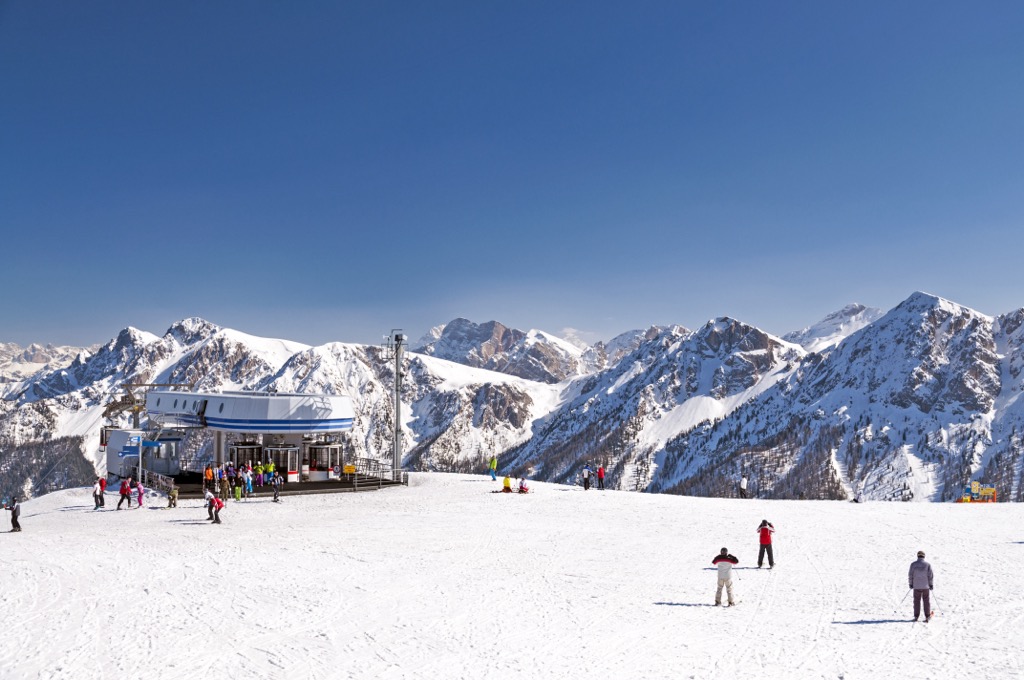
Kronplatz is easy to get around since the mountain has only one cone-shaped peak. A few additional slopes also come down neighboring peaks into San Vigilio di Marebbe. The resort’s website offers an interactive map where you can see which lifts and slopes are open on an overlay of the resort.
Several small isolated ski areas are close to Kronplatz, such as Riepen in Antholz and the ski lift in St. Magdalena (Val Casies / Gsiesertal). However, they are small and only well-suited for beginners and special events like night skiing. Nevertheless, these valleys are world-famous for cross-country skiing and biathlon.
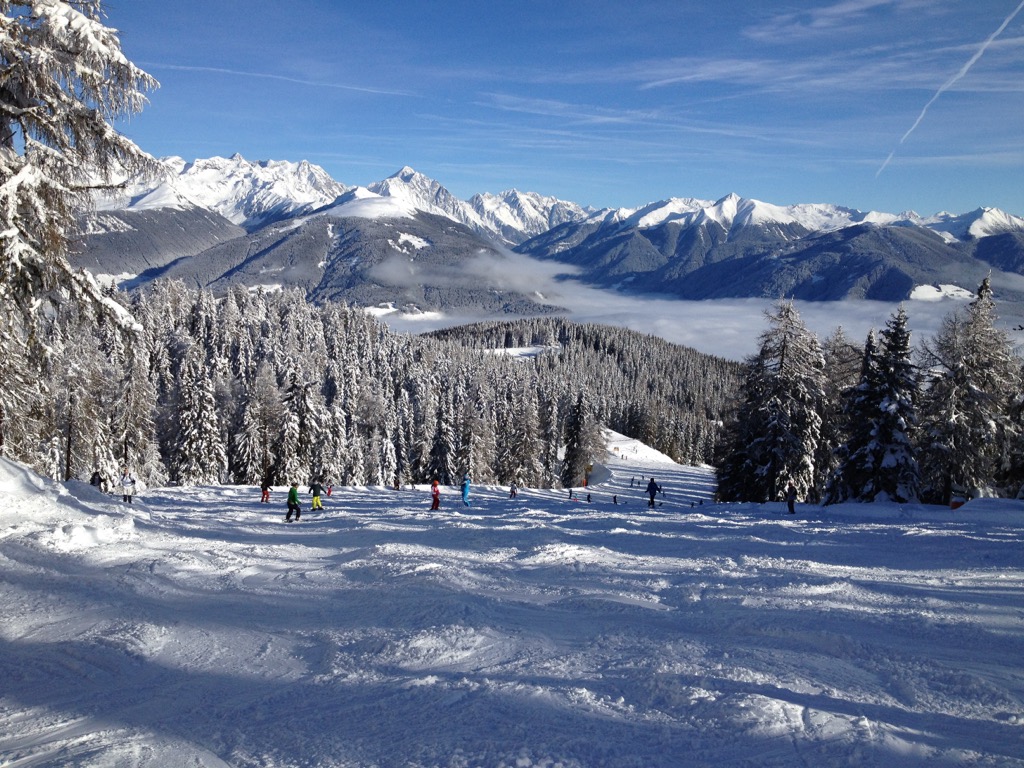
Slopes
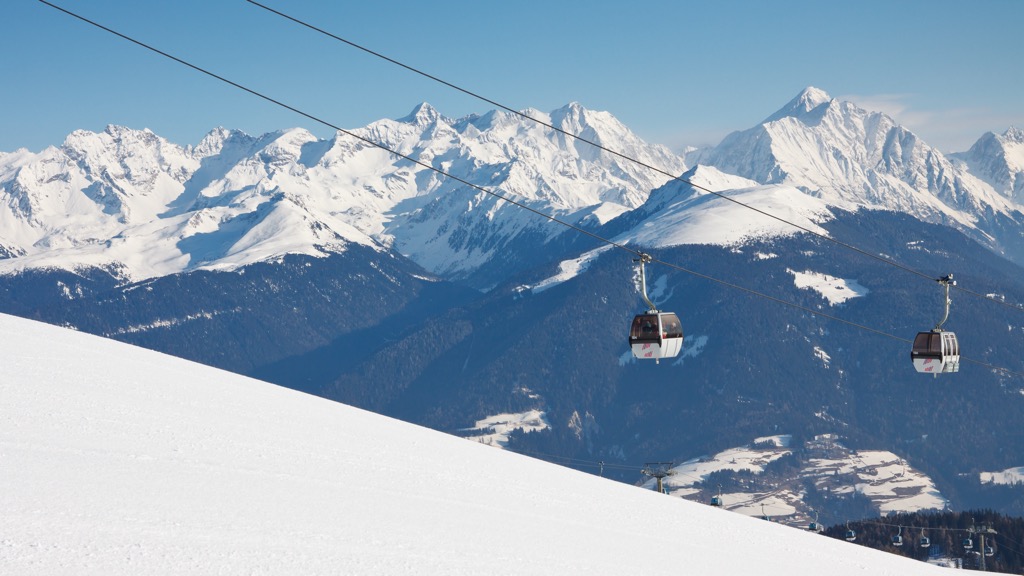
Ski lifts
Other features and services
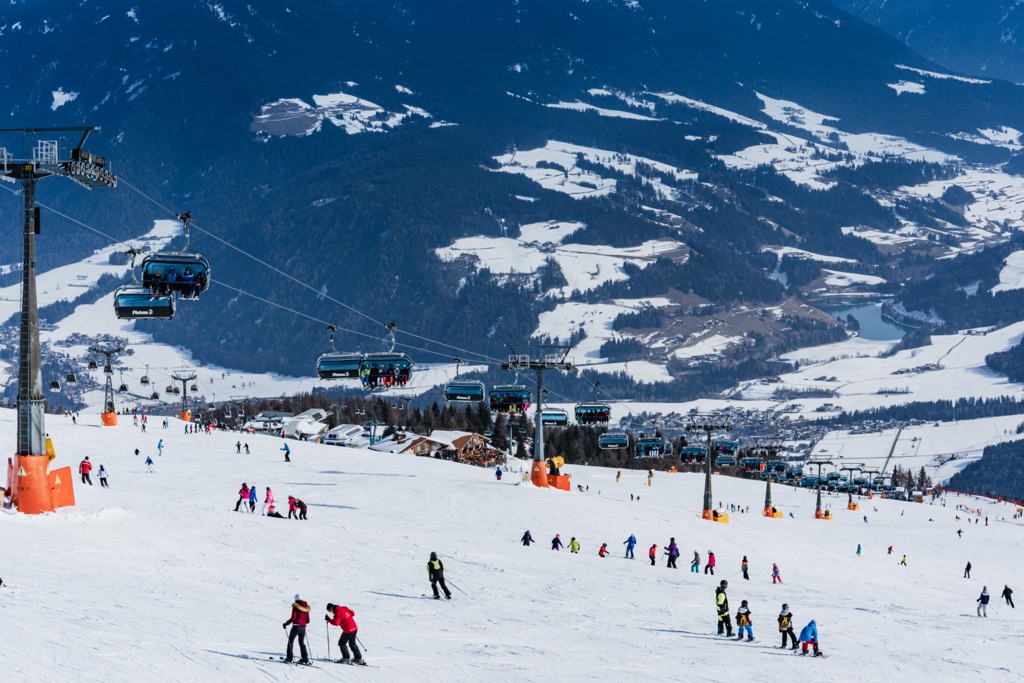
Kronplatz boasts some of the finest on-piste terrain among all ski resorts in Italy, with nearly 120km of ski trails and a skiable vertical of 1,325m, serviced by 32 lifts, including an impressive 23 gondolas. For those who generally dislike chairlifts or open-air, Kronplatz is the ultimate skiing destination. Its efficient lift system is regularly updated and can accommodate many skiers and snowboarders. Just be prepared to take your skis off after nearly every lap.
The on-piste terrain of Kronplatz offers a combination of beginner, intermediate, and advanced trails that can provide full vertical descents of up to 10km, which can be exhilarating. Although some excellent piste trails exist for advanced skiers, this ski resort is more appropriate for families, beginners, and intermediates.
Two north-facing ski runs, Sylvester and Herrnegg, are epic black slopes, some of the most famous of the Dolomites. Here is a guaranteed way to get an adrenaline boost on the way home if you start from Brunico. La Ried, the longest single trail on the mountain, descends from the summit to Perca train station. It is a medium (red) difficulty ski run 7km (4 miles) long with exceptional panoramic views. The east and south-facing slopes descending towards Passo Forca, Valdaora, and Marebbe are wide, easy, and well-suited for beginners.
Although ski mountaineering is popular in the region, it is only advisable for those seeking off-piste powder to come here if there has been recent snowfall. While Kronplatz isn’t famous for its freeriding, various off-piste opportunities do exist throughout the resort - this is Europe, after all. There’s a cute little canyon below Spitzhorn called Mausefalle (mousetrap); many youngsters polish their skills here. Take these deviations with proper care, as some are very technical.
With its advanced lift infrastructure, Kronplatz is essentially immune to lift lines. However, the pistes can get remarkably crowded during peak season holidays and weekends. Without much off-piste terrain, there isn’t quite enough room for everybody to spread their wings around here.
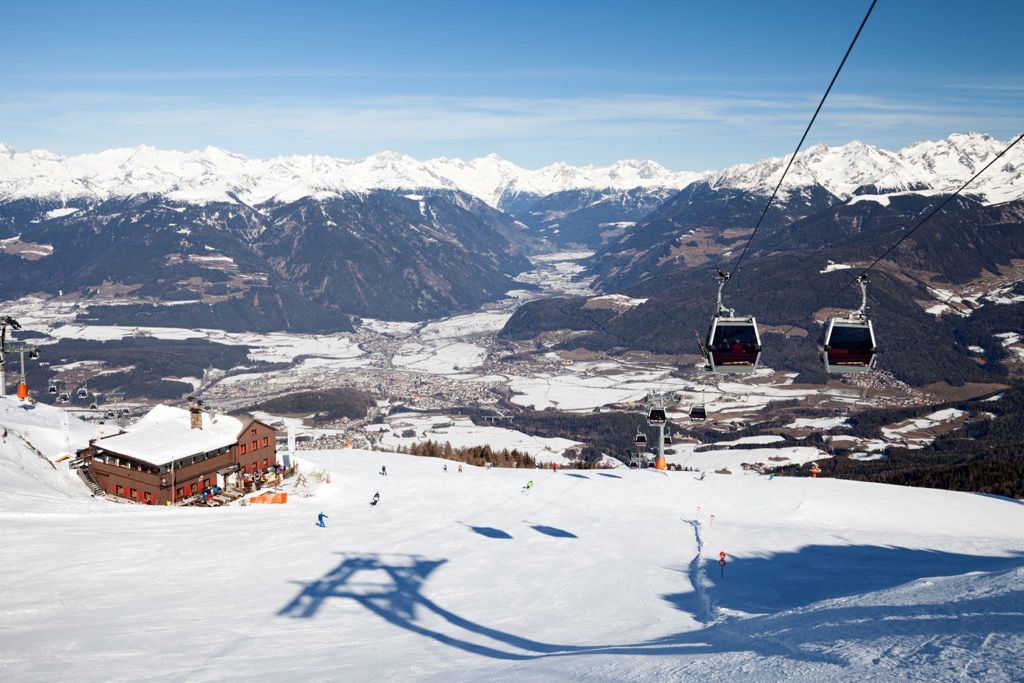
Pustertal, especially the area surrounding Kronplatz, offers various prepared cross-country skiing tracks. It’s no surprise many national teams train here. Antholz Valley will host the 2026 Winter Olympics biathlon competition.
Val Casies / Gsisertal hosts Gsiesertal Lauf - one of the most famous ski marathons in the Alps (there is the ‘just for fun’ option, too). A 5.5 km (3 miles) long cross-country track within Brunico starts from the ski lifts. Finally, scenic routes run deep into the Dolomites, like San Vigilio di Marebbe - Pederü, where majestic mountains distract from sports achievements.
The Dolomites might feel intimidating with all the ferocious mountain faces. While the terrain needs more snow to cover all the rocks, the ski touring views are unbeatable. There are itineraries for all skill levels. Due to excellent transport connectivity with several diverse areas, you’re less than an hour away from dozens of exciting routes and almost guaranteed to find worthy snow.
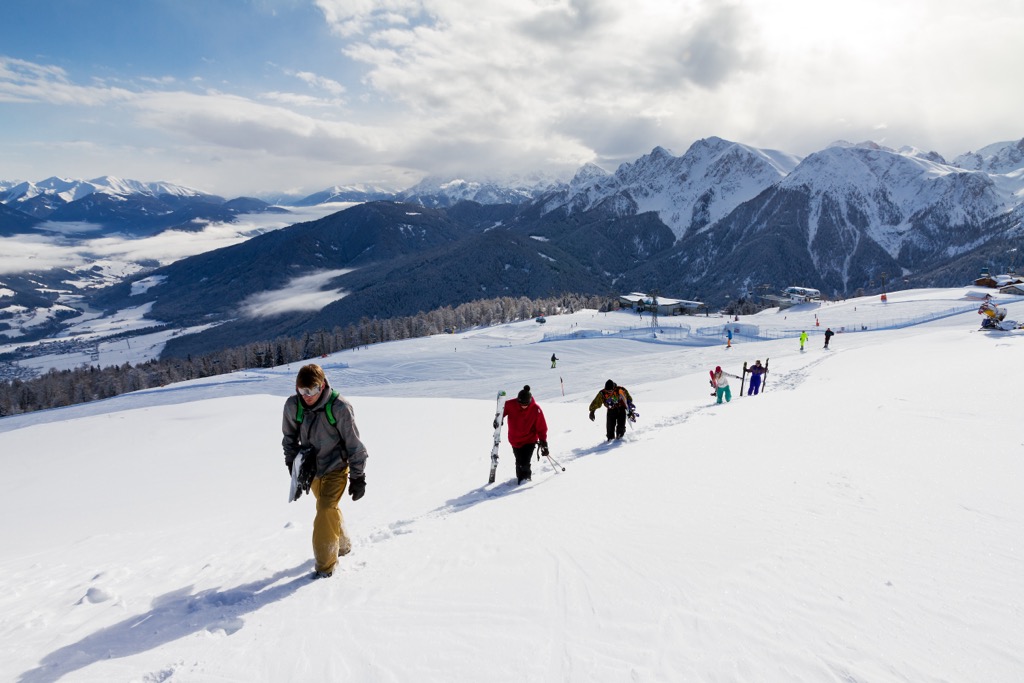
The AVS-Steig ski tour is a classic and regular workout for many passionate ski mountaineers. AVS stands for Alpenverein Südtirol, which is South Tyrolese Alpine Club. This ski tour is an ideal option when the weather prohibits other itineraries.
Starting from the Kronplatz base station in Riscione, the tour follows the AVS-Path to the very summit. It is a workout with 1,365m / 4,478ft of elevation gain and 5.2km / 3.2 miles distance. At the summit, make a well-deserved stop at Alpinn before skiing down one of the black runs (Sylvester or Herrnegg).
Most other itineraries impose an avalanche risk and benefit from local knowledge, so if you’re unsure what you’re doing, hire a guide.
Astjoch is another excellent starter tour, doable in any weather. It is near Brunico, and a bus stops at the bottom. The tour travels past mountain huts if you want to spend a night under the stars. Otherwise, it doesn’t take more than a couple of hours to top out and ski down.
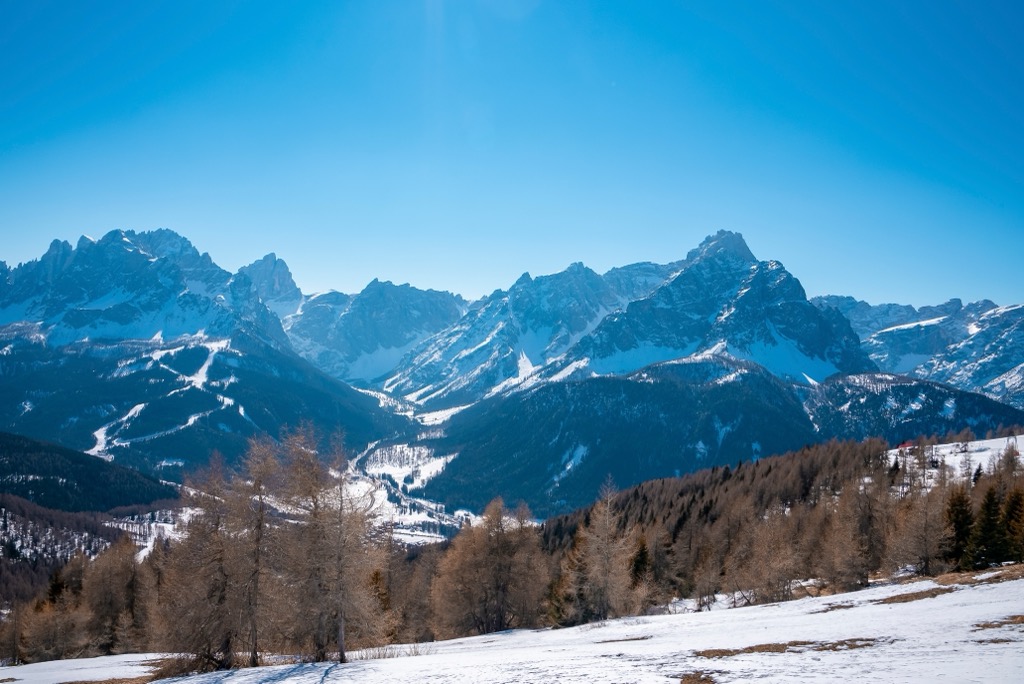
Piz da Peres is a panoramic and "Dolomitic" ski tour. It starts from near the Valdaora cablecar station. Because it traverses a forest and some steep rocky cirques, you need low-elevation snow for this excursion. There is 750 m (2500 ft) of vertical gain, so plan on being in the mountains for at least a few hours. Nevertheless, the Piz de Peres is a relatively short yet scenic view deeper into the Dolomites.
The Weissbach Valley is littered with ski tours. The village has a convenient parking place, right after a small local lift. Most of the tours start from here. The mountain huts in the valley (Marxegger, Pircher, and Innerhofer) are conveniently open in winter and serve delicious meals. Be sure to stop in for a meal after a ski tour. On the other hand, don’t expect solitude; the routes here are popular and well-tracked.
Two options exist for anyone skiing at Kronplatz; a ticket for just the Kronplatz slopes or a Dolomiti Superski pass. There are three different price tiers based on the time of year: early season, high season, and regular season. The Dolomiti pass is about 5 euros more per day. There are also discounts for multiday passes. Check out this PDF for all of the details on day tickets.
Season Passes are 854 euros for just Kronplatz (if you buy online) and 890 euros for the entire Dolomiti Superski. With 12 ski resorts, the Dolomiti pass is the bargain here. Keep in mind that you must ski approximately 20-25 days over the season for the Season Pass to pay itself off.
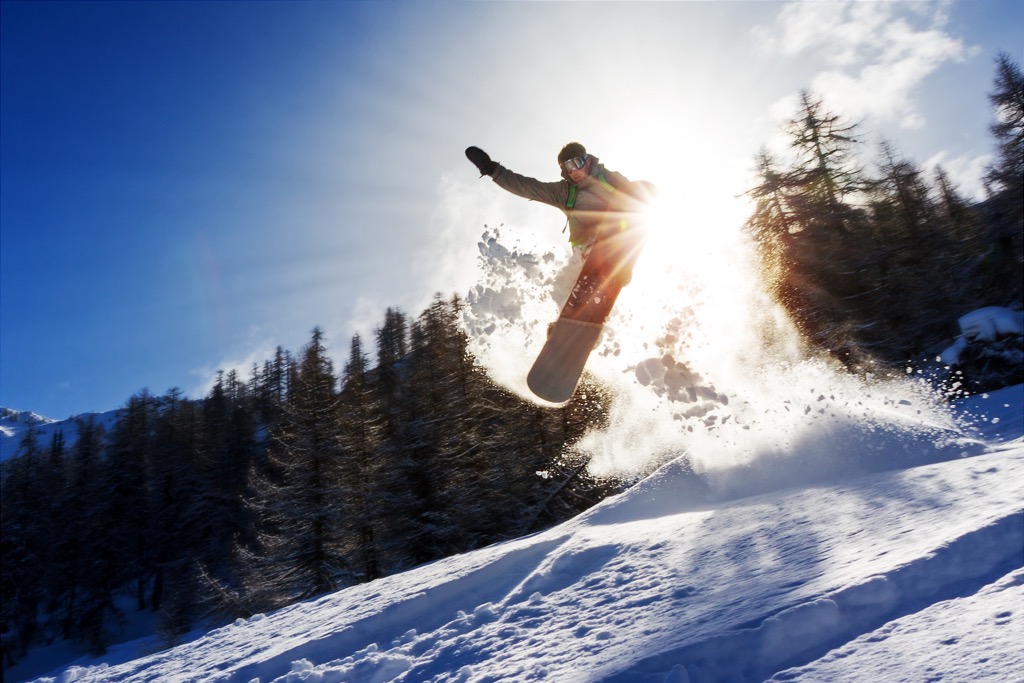
Tourist Office Bruneck Kronplatz Tourism
Piazza Municipio / Rathausplatz 7
I-39031 Brunico / Bruneck
Tel. +39 0474 555722
info@bruneck.com
Italians are known for their cuisine, and Kronplatz doesn’t disappoint. Naturally, there are many options in this vast ski resort. The prices are a bit above average for Italy, although you won’t bat an eye if you come from the United States or Northern Europe.
Alpinn is at the top of the mountain in the same building as the Lumen Museum (more on that below). It’s not just the fantastic views; world-class chefs prepare local specialties with farm-fresh ingredients. Book your table on the website’s front page before going, as it fills up fast. If you’re willing to fork out 60-90 euros, you can participate in one of the Prix Fixe experiences, featuring several courses. You can also do A La Carte.
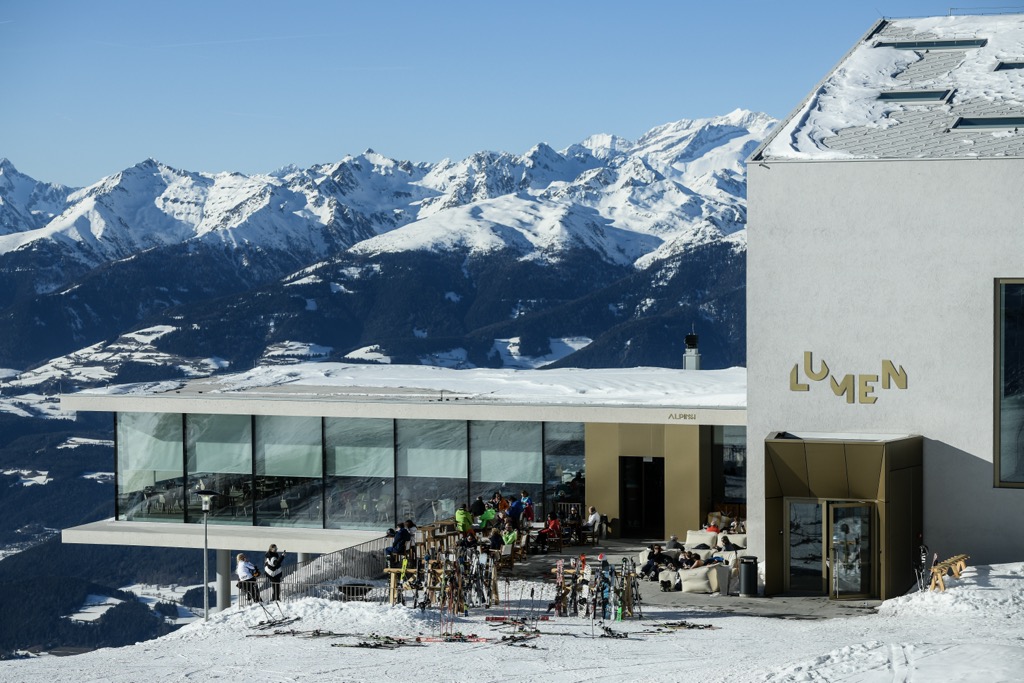
Oberegger Alm is another ski-in-ski-out experience of a humbler sort. This small hut is just off the piste at 1560 m (although you can also drive there if skis aren’t your thing). The food and decor are more traditional, and the prices are lower. It’s popular with locals and opens every day of the season from 11:30 to 3:30.
Picio Pre occupies a niche somewhere between Alpinn and the Oberegger in terms of price. Only skiers and snowboarders can get here, though, as it’s away from the lifts on the side of a black run.
Cafe Restaurant Cosmo in the center of Brunico offers the perfect village ambiance, tasty food, and sumptuous desserts.
Looking for a place to stay in Kronplatz? Here are some of the best accommodation options in the area:
Brunico
Brunico (German: Bruneck) is one of the key towns in South Tyrol and a popular tourist destination for mountain holidays.
The central historic district is one of the most beautiful in the Alps; it is a cozy medieval village with a modern history dating back to 1256, although there are also traces of Romans in the area. The town gained popularity in the 15th century due to its strategic position on the route between Germany and Venice.
Brunico sits at the confluence of three major valleys:
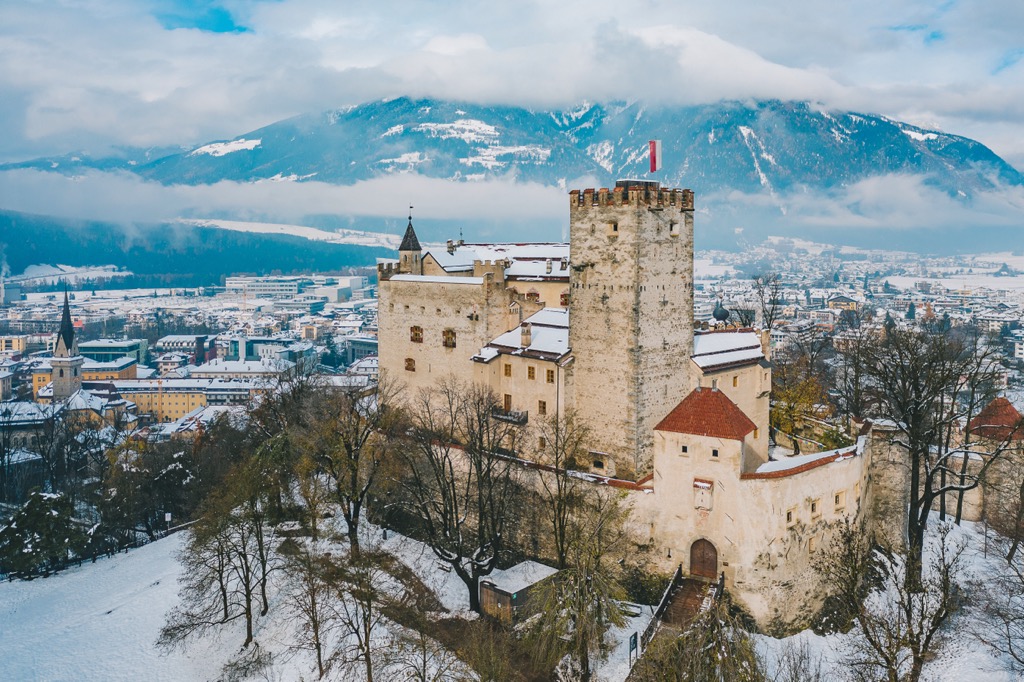
San Vigilio di Marebbe
Cozy and authentic San Vigilio di Marebbe is embroiled in the gorgeous mountain scenery south of the Kronplatz mountain. The village is much smaller than Brunico, yet no less intriguing. With Kronplatz ski lifts crossing through the village center and cross-country tracks right from the houses, it might be even more convenient for the winter holidays. One of the highlights is a 22 km (13 miles) cross-country and winter walking trail running deep into Fanes-Sennes-Prags Nature Park. The scenery of Marebbe Valley is nothing short of a fairy tale.
Valdaora / Olang
To the east of Kronplatz Mountain, there’s Valdaora. It is a small village with a ski shuttle connection to ski lifts. This village offers more economical accommodation than Brunico and San Vigilio di Marebbe.
Kronplatz
There are also several luxurious stays on the slopes, such as the Alpin Panorama Hotel Hubertus, featuring one of the most photographed sky pools in the Alps.
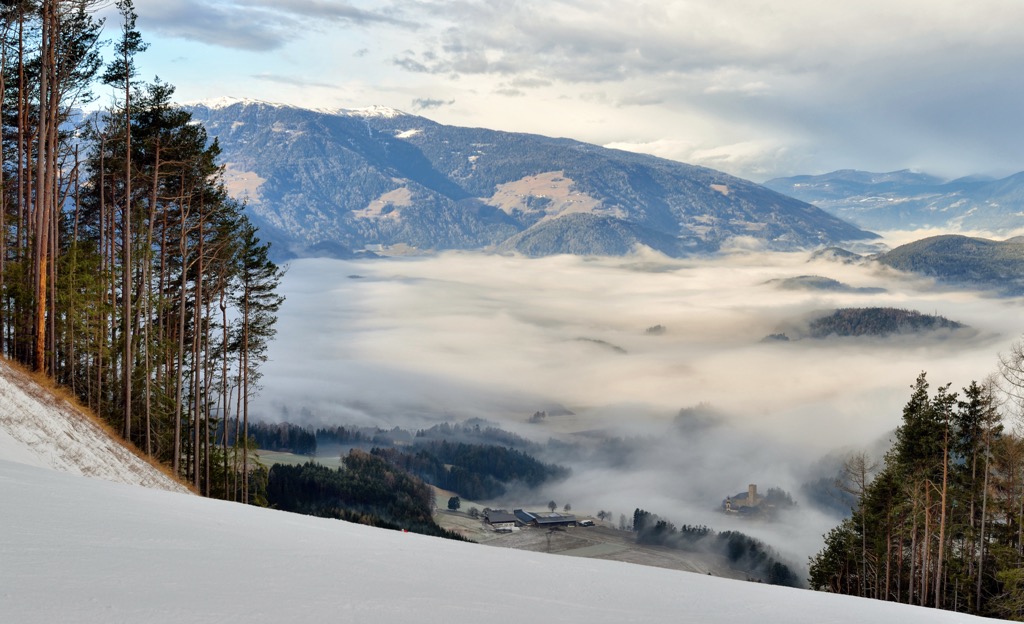
Kronplatz regularly hosts events throughout the year since it boasts such a vast area in a scenic location. Stay up-to-date on the events page of the website.
The Kronplatz Ski & Music Festival takes place every March and is a great place to sit back and see talented acts on the slopes and in town.
Kronplatz is relatively quiet after the slopes empty out. Don’t expect any St. Anton-esque club scene in Brunico or elsewhere. The vibe here is relaxed and family-friendly. Folks like to frequent the many spas, jacuzzis, or sky pools in the various hotels around town. Locals head to the town center, stopping by Toni ‘The Chestnut Man’ and his kiosk for local morsels and hot wine.
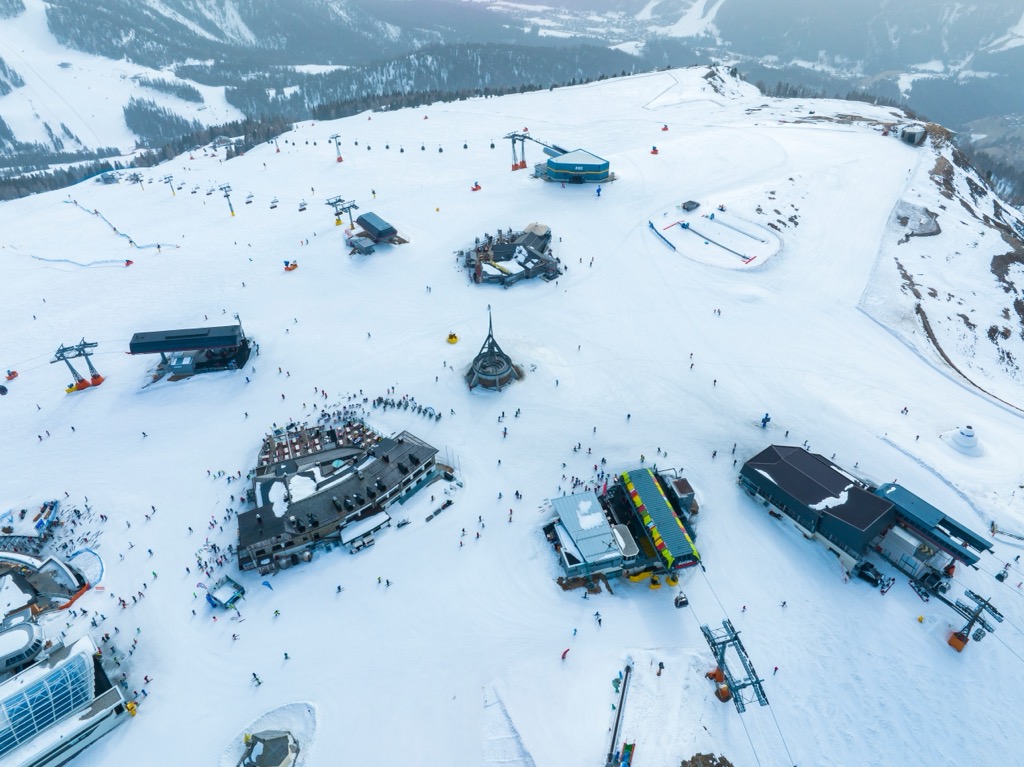
Counting all the castles in the area is hard, never mind all the other marvelous wonders. But here’s a list of places I like the most around Kronplatz.
Directly to the north of Kronplatz, the Ahrntal Valley opens up. It features its own Skiwelt Ahrntal resort, a fairy tale Taufers Castle (among many others), and a tough Via Ferrata named after world-famous alpinist Hans Kammerlander. The most crucial feature of Ahrntal in winter is the snowfall - it’s the northernmost valley in Italy and one of the country’s snowiest places. It dumps a lot here!
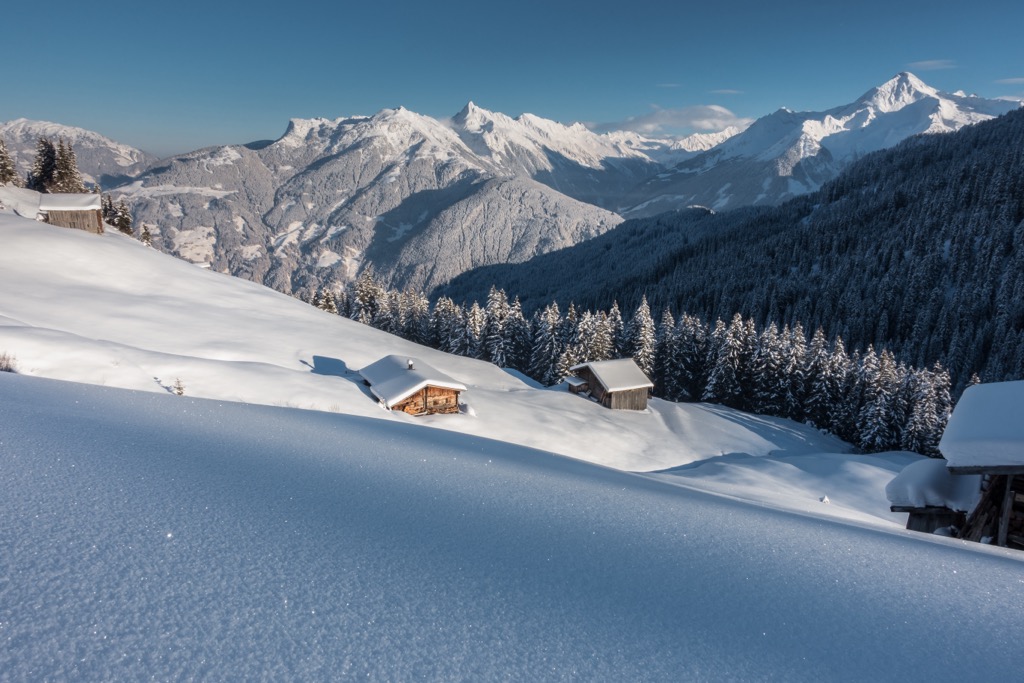
A 2026 Olympics location, Antholz will host a biathlon competition. Antholz Lake (Lago di Anterselva / Antholzersee), with a backdrop of imposing 3000 m peaks, is among the most beautiful in South Tyrol. There’s a loop trail around the lake with numerous viewpoints and a restaurant.
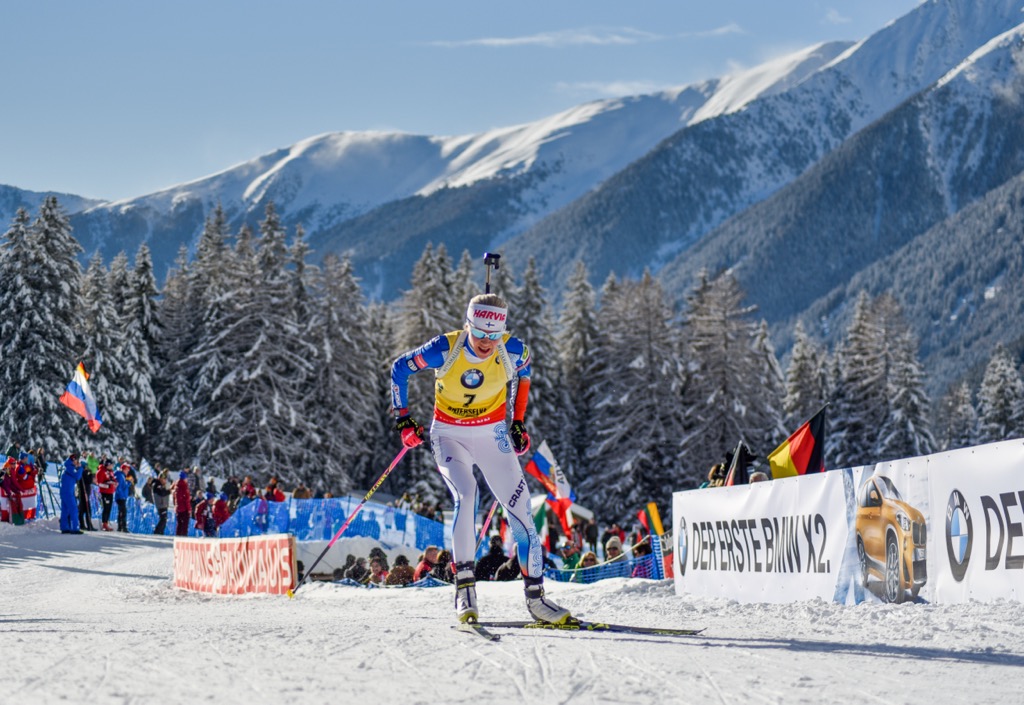
The Earth Pyramids in Percha began to form several hundred years ago during a landslide caused by a storm. In 1882, another storm created a large trench. Repeated flooding eventually produced loamy pillar structures with heavy stones at the top. Not surprisingly, the pyramids continue to change, and new pillars appear regularly, especially in winter and spring.
Kronplatz Mountain isn’t limited to winter sports only. Even non-skiers will find a visit to the summit enjoyable. Two museums await visitors at the summit: the Messner Mountain Museum and Lumen.
The Kronplatz Mountain installment of the Messner Mountain Museum opened in 2015. It was the final in a series of six museums conceived by Reinhold Messner, one of the most famous alpinists in the World. Messner was the first climber to summit all 14 8,000 m peaks and the first to summit Everest solo, as well as without oxygen. Five other MMMs are spread throughout the region surrounding South Tyrol.
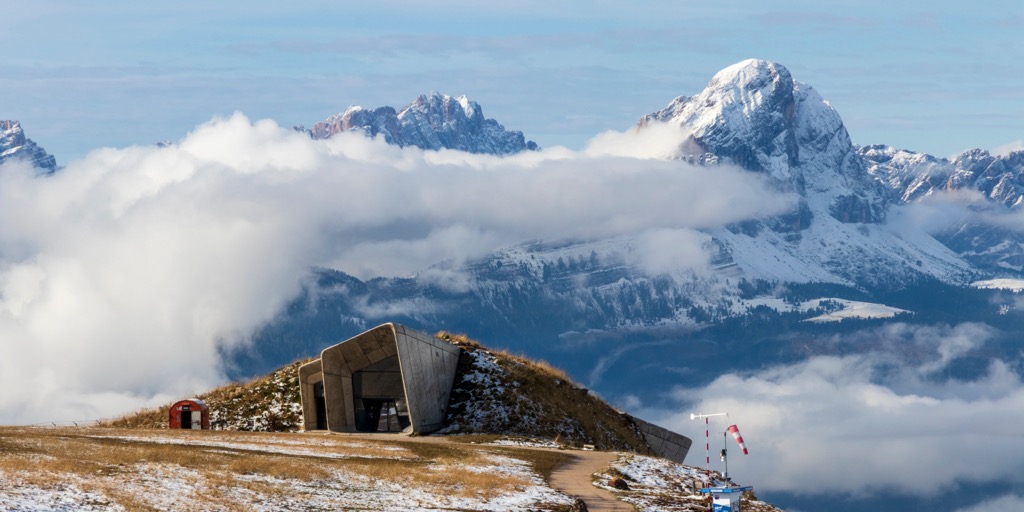
The museum building is state of the art and attracts with its architectural solutions by Zaha Hadid. The museum’s interior has echoes of a tunnel carved by ice and water and features tools of famous alpinists, models of iconic peaks, and paintings of mountains.
The Kronplatz installment’s focus is traditional Alpinism. Messner states, “On Kronplatz, I present the development of modern mountaineering and 250 years of progress with regard to the equipment. I speak of triumphs and tragedies on the world’s most famous peaks – the Matterhorn, Cerro Torre, K2 – and the depiction of our activity, however contradictory it may seem. As in my other museums, I shed light on alpinism with the help of relics, thoughts, works of art (pictures and sculptures) and by reflecting the outside mountain backcloth in the interior of MMM Corones.”
Lumen opened in late 2018 with permanent exhibitions on the history of mountain photography. The museum’s website states, “Spanning four floors, LUMEN offers the possibility to experience the history of mountain photography from its beginnings until the present as well as displaying the art of mountain photographers from all over the world. A scientific approach and entertainment are not contradictions — LUMEN shows historic pictures and digital innovations, exciting temporary and special exhibitions, as well as spectacular productions.”
The price of admission is 17 euros for adults or 20 euros for a combined pass to Lumen and the MMM. To complete the cultural program, visitors can dine at the stellar AlpiNN restaurant in the same building as the Lumen Museum.
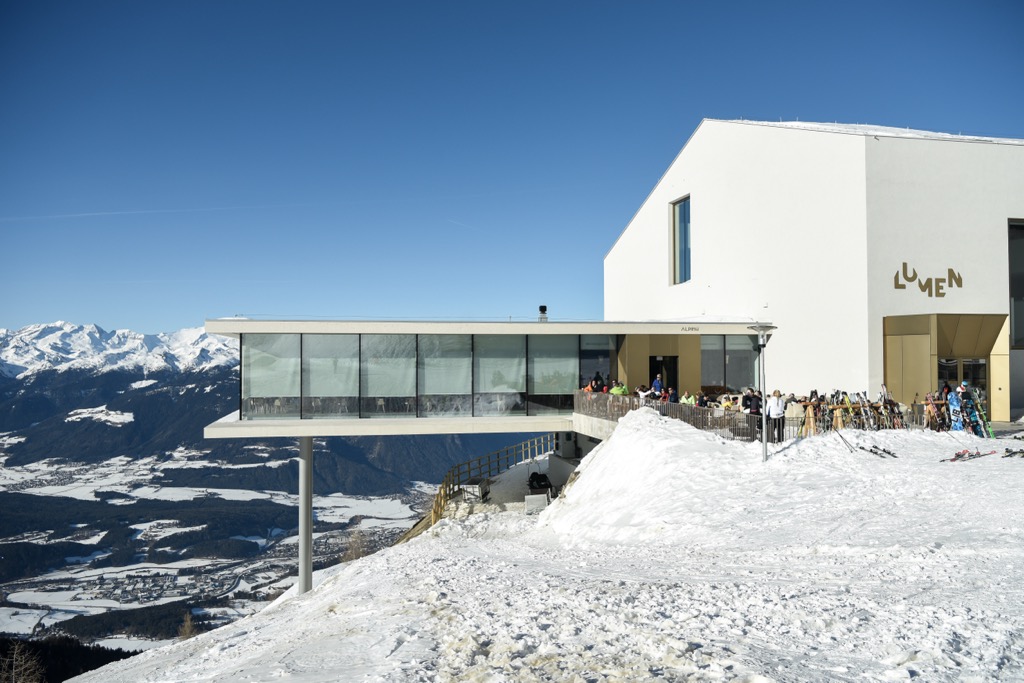
Other notable museums in the area include Museum Ladin in the San Martino Castle (Ciastel de Tor in Ladin) and Messner Mountain Museum Ripa, dedicated to people of the mountains in Schloss Bruneck.
Kronplatz is part of the Dolomiti Superski area, and it's conveniently located just a short train or bus ride away from several other ski resorts in the Dolomites. The closest one is Alta Badia, approximately 11km from the Piculin gondola base at Piccolino. Skiers can take a ski bus that connects the Piculin gondola in Kronplatz to the Sponata chairlift in Alta Badia. Another nearby Dolomiti Superski resort is the charming 3 Peaks Dolomites (Drei Zinnen), which is only half an hour away by train and directly connects to the ski lifts from the station.
